Tribal Displays: Colonial Repositories and Community Reconciliation
The practices of a new museology have recently raised debates involving public forums and dialogues. However, these transformation processes have also sought to rethink museum practices in remaking persons and remaking society. The practice of displaying ethnic groups in the museum builds on the debates of decolonising museums especially of those having ethnographic artefacts. Having spent some periods of time in the work with ethnography, I point out that the characteristics of several ethnographic collections in the Uganda National Museum relate to the stories associated with creating tribal groups as well as with governing those tribes in order to legitimise the colonial rule. In other words, the Uganda Museum was a special institution of the colonial administration that worked to implement indirect rule in Uganda. This paper seeks to ask how the idea of a new museology in a contested history of violence uses the space of the museum galleries to rebuild society from the experiences of war trauma.
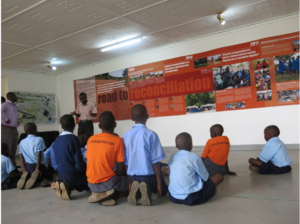
Road to Reconciliation Exhibition, Uganda Museum 2013. Photograph taken by Abiti Nelson.
In this paper I argue that the work of the museum in Uganda was founded by the British colonial governance in 1908 by Sir Henry Hesketh Bell when ethnographic objects were assembled into tribal crafts and ethnic cultures in the first Sikh temple museum in Uganda. As the museum was founded, the storage cabinet and displays of the ethnographic material in the early periods in Uganda presented different meanings. To the local population, the presentation of the first museum was called ‘enyumba ya amayembe’ (house of spirit). The keeper of the museum was ‘omukulu ya amayembe’ (the head of spirit). However, as we very well know, larger museums in the world had high prestige positions as ‘keepers of ethnography’. Towards the 1950s, the question of collecting ethnographic objects, their selection and the remaking of the exhibition displays of the Uganda Museum brought forward the notion of ‘contemporary tribal crafts’. These phases of the museum’s development and the making of the exhibition were reflections of how the Ugandan society was mirrored in the ethnographic section of the Uganda Museum as ‘peopling of Uganda’. The Ugandan people were supposed to come and see themselves in the ethnographic displays. In the debates about rethinking the museum, who then decides to tell the story of society or community in a museum? Why has this ethnographic display continued to persist in the independent nation of Uganda?
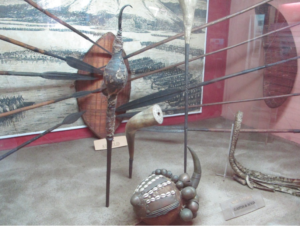
Fetish objects on display in the ethnographic section of the Uganda Museum formally named Enyumba ya mayembe. 2013. Photograph taken by Abiti Nelson.
Furthermore, the curatorial practice in the museum are sometimes determined by the national politics. The relationship between the tribal ethnographic objects and the national identity in the Uganda museum shows how tribal structures were formed as a result of collecting or assembling the ethnographic objects. The period of independence was a period in which the mobilisation of ethnographic objects occurred. The earliest ethnographic objects that were returned were remade into a national treasure as well as historical display at Uganda Museum.
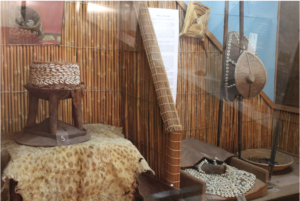
The Kibuuka objects in the display at History section of the Uganda Museum, returned from University of Cambridge 1962. Photograph taken by Abiti Nelson 2017.
The period of nationalism and the formation of the new nation Uganda were related to the ways in which museum exhibitions began to change. These changes led to an enactment of museums as national monuments, national museum galleries and development initiatives being exhibited at the museums in agreement with national narratives. However, the museum practices at that particular period of post-independence were based on liberating society from colonialism. But this was not a reflection of cultural representation. The politics of national identity and museum practices during the post-independence period led to abolishing the functions of a royal system of governance that later caused the attack on the Buganda palace in 1966 and the subsequent confiscation of royal regalia in 1967 by President Milton Obote. During the Idi Amin regime, the ethnographic objects of the various ethnic cultures that were formally being kept at the Uganda Museum were remade and redistributed as national artefacts into the newly created regional museums of Uganda. Although the militarization of the nation led to changes in the exhibition displays and the collection of objects during independence, it showed violence in Uganda. However, the historical legacies of indirect rule and the exchanges of ethnographic objects between the Uganda museum and the European museums have not been accounted in the interpretation of meanings to society. This suggests that the militarization of the nation and the violence in Uganda had and have implications on the ways through which 21st century museum practices are being thought of and through which they change the meanings of ethnographic objects.
Towards the 1980s, Ugandan society experienced civil wars and forceful displacements of people into the concentrated Internal Displacement Camps. In order to restore peace and recover from violence, the chiefdom of Luo Ker Kwaro Acholi began to re-enact the ritual cultural practices of Wong tong, (stepping on the eggs) and Mato oput (drinking bitter roots) to cleanse the impurities of bloodshed and to bring about informal forgiveness and reconciliation. These ritual ceremonies were performed as a result of post-war psycho-social traumas when communities lost their relatives in the wars.
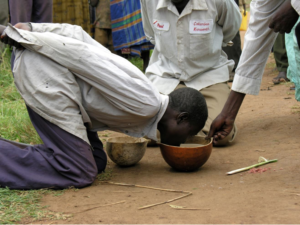
Mato oput in Lukodi, Gulu 2011@ Justice reconciliation project. Photograph taken by JRP team.
The involvement of the Uganda National Museum’s work in documenting the reburials, the question of unburied dead and missing persons – without graves and representation – have recently changed the curatorial practices of the museum as a forum for dialogues. Therefore, by 2010, the Uganda National Museum sought to change its curatorial practice by enabling processes of mediating
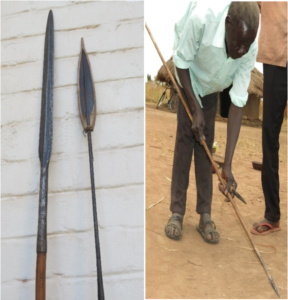
the dead, forgiveness and social remembering after decades of civil wars that destroyed human life and livelihood of communities in Uganda. However, this new museology still encounters the ethnographic project of colonialism that displays ethnic artefacts at Uganda National Museum.
In my view, the museum practice must be listening and working towards building society. The example of the communities in northern Uganda, who embarked on social ceremonies as form of healing are significant for highlighting cultural ways of transmitting knowledge that is intended to manage conflicts and rebuild societies, using objects to express reconciliation in northern Uganda (Abiti 2015). The community memorial process also points to a debate about understanding the processes of memory-making in a local community, including how people’s participation in a museum project might define its future outcome.
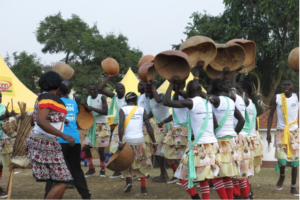
Gulu performing artists at Uganda Museum 2016. Photograph taken by Abiti Nelson.
The concept of museum with ethnography is an old style and raises the question of what happens when Ugandans visit the Museum, how do they see themselves? What kind of stories do we want to tell contemporary Ugandans? How does a young audience mediate exhibitions linked to violence? Are the Ugandan Museum’s old exhibitions going to be reorganized, and if so, how and who will be involved? Will the process of reimagining new museology practice become institutionalized in management practice? What will finally happen to the concept of ethnography in museums? Should it be a dialogue, a rethinking, a reconciliation and a questioning of the old gallery?
Nelson Adebo Abiti is PhD student of University of Western Cape and the curator of ethnography at the Uganda National Museum. He holds an MA from the University of East Anglia (2015), received his Bachelor’s degree from Makerere University (2003) and studied for a Diploma in Museums and Heritage Studies at the University of Western Cape, South Africa. From 2010 to 2013, Abiti headed a team of Uganda National Museum staff and Norwegian partners, who collaborated with several communities in northern Uganda to preserve and present the regional memory and, thereby, promote peace and reconciliation following a long civil war. The result of this cooperation was an exhibition entitled Road to Reconciliation. Currently, Abiti has been a core team member of the cooperation project between the Uganda National Museum, Igongo Cultural Centre and Ethnographic Museum at the University of Zurich, which jointly curated exhibitions in Uganda and Switzerland since 2015. Abiti recently co-curated the exhibition project of ‘Unseen Archive of Idi Amin’ with the University of Michigan and University of Western Australia that opened at Uganda Museum during the International Museums Day 18th May 2019.































